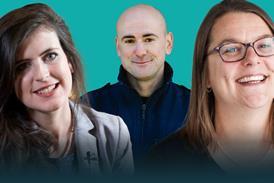- Home
- Shows
- Articles
- Connect
-
Topics
- Back to parent navigation item
- Topics
- Apologetics
- Art & imagination
- Atheism
- Bible: New Testament
- Bible: Old Testament
- Children & young people
- Christian living
- Church
- Culture
- Ethics
- Evangelism
- God
- History
- Jesus
- News & Events
- Other religions
- People & Influential Figures
- Philosophy
- Political
- Religious Seasons
- Science
- Sexuality & gender
- Social issues
- Suffering
- Technology
- Theology
- Wellbeing
- Courses
- Unbelievable? Live
- Donate
‘Science is not enough’
2022-11-25T16:16:00

Scientist Dr Sy Gate was a convinced atheist who thought the Church was the main enemy of humanity. Through his scientific study and a number of dreams, Sy begin to question his firmly held beliefs
Want to read more? REGISTER FREE for Premier Unbelievable? Membership!
If you are already a Member or have an account with another Premier website, you can SIGN IN now.
Register for a FREE Premier Unbelievable? Membership
Be equipped to confidently defend your Faith, tackle untruths and demonstrate that the Gospel is good news for everyone.
Membership includes unlimited access to the website, a weekly newsletter, bonus content and much more.
To continue reading REGISTER FOR FREE MEMBERSHIP
Related articles
-
 Article
ArticleRunning from God – a Jehovah’s Witness’ journey away from and back towards God
2023-01-18T15:00:00Z
Claire Dooley grew up in a large religious family in Mississippi. Here, she shares some of her reasons for leaving the faith and why, after years of atheism and in her moment of deepest despair, she started exploring Christianity
-
 Shows
ShowsThe CS Lewis Podcast #205 Alister McGrath: Lewis on science and evolution
2025-04-14T16:00:00Z
In this episode, Ruth Jackson speaks with Alister McGrath about Lewis’ views on evolution and science. What did Lewis believe about evolution, and how did he separate it from philosophical naturalism? Did he think evolution could explain things like morality and consciousness?
-
 Shows
ShowsS2 #14 Sin, Sex, and Salvation? NT Wright on Contraception, the Cross, and the Church
2025-04-13T07:00:00Z
Is contraception a theological issue? Can we trust the Gospels as historical documents? How should the church respond to political idolatry? And what really happened on the cross? In this episode of Ask NT Wright Anything, Tom Wright and Mike Bird tackle pressing questions about modern faith and ancient texts. They explore the evolving Christian views on contraception, the historical reliability of the Gospels, and the dangers of confusing politics with discipleship.
More from Articles
-
 Article
ArticleCan one weekend give you everything you ever wanted?
2025-04-15T11:23:00Z
Graham Albans explores the emptiness behind our achievements and suggests Easter weekend’s events might hold the key to true fulfillment. Could the life, death, and resurrection of Jesus offer everything we’ve ever wanted?
-
 Article
ArticleChasing Eden: Why We Long for a World That Never Was - or Was It?
2025-04-14T11:00:00Z
Part 2 of our 4-part series Reflections on the Ontological Argument
-
 Article
ArticleFrom Theistic Evolution to Intelligent Design: Why I changed my mind
2025-04-10T08:51:00Z
Part 1 of 4: Wrestling with the Divide - Why I Couldn’t Keep Faith and Science Apart Anymore
- Topics A-Z
- Writers A-Z
- © 2025 Premier Christian Communications Ltd
Site powered by Webvision Cloud


















